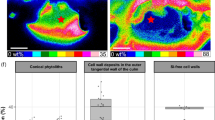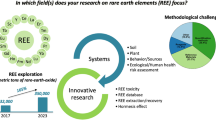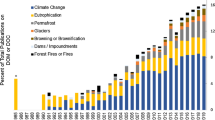Abstract
Paleolimnology provides long-term data that are often essential for understanding the current state of the environment. Even though there is great potential, paleolimnology is rarely used together with process-related studies to solve issues regarding cycling of elements in the environment. Clearly, this is a drawback because the cycling of many elements, which cause great concern in the present-day environment, was altered long before the advent of monitoring programs. The pioneering work of C.C. Patterson and his colleagues emphasized the importance of a long-term perspective for understanding the current cycling of metals, with a focus on lead, and in particular for estimating background concentrations and human-related impacts in the environment. In Sweden the first traces of atmospheric lead pollution are found in lake sediments dated to about 3500 years ago. The long-term changes in the pollution lead record in lake sediments led us to consider how lead biogeochemistry has changed over time in response to this historical deposition—where has this lead gone, and how much does this lead contribute to the present-day biogeochemical cycling of lead? How was lead distributed in ‘pre-industrial’ soils or more properly in natural soils not impacted by atmospheric pollution? There are many studies that have examined the effects of increased metal concentrations on soil biota, but what are the appropriate background conditions for comparison? Using lake sediments as our foundation we have analyzed lead, including its stable isotopes, in other environmental compartments, including peat, soil, and a range of boreal forest plant species, to develop a better understanding of the fate of lead derived from long-term pollution. Three important conclusions from our studies in Sweden are: (1) atmospheric lead deposition rates during the 20th century were 100 to as much as 1000 times higher than natural deposition rates a few thousand years ago. Even with stricter emission standards during the past three decades and the resultant reductions in deposition, lead deposition rates today are still 10–100 times greater than natural rates. This increase in deposition rates modeled from sediment and peat records is of a similar scale to estimated changes in body burdens of lead in modern versus ancient humans. (2) In Europe about half of the cumulative burden of atmospherically deposited lead was deposited before industrialization. In southern Sweden the cumulative burden of pollution lead during the past 3500 years is 2–5 g Pb m−2 and in the ‘pristine’ northern parts of the country there is about 1 g Pb m−2. (3) Predicted recovery rates for soils are slow; in the cold climate of Scandinavia, we find that the soil surface (O horizon), where most soil biota reside, retains lead deposited over the past 150–500 years. Therefore, although lead deposition rates in Europe, as well as N. America, are only 10% of those a few decades ago, it will take several decades or longer for lead concentrations in soils to respond appreciably. The slow turnover rates for lead in the environment and gradual immobilization of lead in deeper soil mineral horizons also inhibits a loss of lead to surface waters in areas removed from point sources.






Similar content being viewed by others
References
Andersson A, Nilsson Å and Håkanson L (1992) Metal concentrations of the mor layer. Swedish Environmental Protection Agency, p 85
Bacon JR, Hewitt IJ (2005) Heavy metals deposited from the atmosphere on upland Scottish soils: chemical and lead isotope studies of the association of metals with soil components. Geochim Cosmochim Acta 69:19–33
Bacon JR, Jones KC, McGrath SP, Johnston AE (1996) Isotopic character of lead deposited from the atmosphere at a grassland site in the United Kingdom since 1860. Environ Sci Technol 30:2511–2518
Bacon JR, Farmer JG, Dunn SM, Graham MC, Vinogradoff SI (2006) Sequential extraction combined with isotope analysis as a tool for the investigation of lead mobilisation in soils: application to organic-rich soils in an upland catchment in Scotland. Environ Pollut 141:469–481
Bindler R, Brännvall M-L, Renberg I, Emteryd O, Grip H (1999) Natural lead concentrations in pristine boreal forest soils and past pollution trends: a reference for critical load models. Environ Sci Technol 33:3362–3367
Bindler R, Renberg I, Anderson NJ, Appleby PG, Emteryd O, Boyle J (2001a) Pb isotope ratios of lake sediments in West Greenland: inferences on pollution sources. Atmos Environ 35:4675–4685
Bindler R, Renberg I, Brännvall M-L, Emteryd O, El-Daoushy F (2001b) A whole-basin study of sediment accumulation using stable lead isotopes and flyash particles in an acidified lake, Sweden. Limnol Oceanogr 46:178–188
Bindler R, Klarqvist M, Klaminder J, Förster J (2004) Does within-bog spatial variability of mercury and lead constrain reconstructions of absolute atmospheric deposition rates from single peat records? The example of Store Mosse. Global Biogeochem Cycles 18:GB3020 doi:3010.1029/2004GB002270
Blanchard I (1976) English lead and the international bullion crisis of the 1550s. In: Coleman DC, John AH (eds) Trade, government and economy in pre-industrial England. Weidenfeld, London, pp 21–44
Brännvall M-L, Bindler R, Renberg I, Emteryd O, Bartnicki J, Billström K (1999) The Medieval metal industry was the cradle of modern large-scale atmospheric lead pollution in northern Europe. Environ Sci Technol 33:4391–4395
Brännvall M-L, Bindler R, Emteryd O, Renberg I (2001a) Four thousand years of atmospheric lead pollution in northern Europe: a summary from Swedish lake sediments. J Paleolimnol 25:421–435
Brännvall M-L, Bindler R, Emteryd O, Renberg I (2001b) Vertical distribution of atmospheric pollution lead in Swedish boreal forest soils. Water Air Soil Pollut: Focus 1:357–376
Brännvall M-L, Kurkkio H, Bindler R, Emteryd O, Renberg I (2001c) The role of pollution versus natural geological sources for lead enrichment in recent lake sediments and surface forest soils. Environmental Geology 40:1057–1065
Brill RH, Wampler JM (1967) Isotope studies of ancient lead. Am J Archaeol 71:63–77
Bringmark L, Bringmark E, Samuelsson B (1998) Effects on mor layer respiration by small experimental additions of mercury and lead. Sci Total Environ 213:115–119
Brodin Y-We (1997) Vem förorenar Sverige? (Who pollutes Sweden?). Naturvårdsverket (Swedish EPA), Stockholm, p 42
Brown JS (1962) Ore leads and isotopes. Econ Geol 57:673–720
Bryson B (2003) A short history of nearly everything. Doubleday, London, 500 pp
Chow TJ (1965) Radiogenic leads of the Canadian and Baltic Shield regions. Symp Marine Geochem 3:169–184
Chow TJ, Bruland KW, Bertine KK, Soutar A, Koide M, Goldberg ED (1973) Records in Southern California coastal sediments. Science 181:551–552
Deboudt K, Flament P, Weis D, Mennessier JP, Maquinghen P (1999) Assessment of pollution aerosols sources above the Straits of Dover using lead isotope geochemistry. Sci Total Environ 236:57–74
Dörr H, Münnich KO (1991) Lead and cesium transport in European forest soils. Water Air Soil Pollut 57–58:809–818
Farmer JG, Eades LJ, MacKenzie AB, Kirika A, Bailey-Watts TE (1996) Stable lead isotope record of lead pollution in Loch Lomond sediments since 1630 A.D. Environ Sci Technol 30:3080–3083
Farmer JG, MacKenzie AB, Sugden CL, Edgar PJ, Eades LJ (1997) A comparison of the historical lead pollution records in peat and freshwater lake sediments from central Scotland. Water Air Soil Pollut 100:253–270
Farmer JG, Eades LJ, Graham MC (1999) The lead content and isotopic composition of British coals and their implications for past and present releases of lead to the UK environment. Env Geochem Health 21:257–272
Farmer JG, Eades LJ, Atkins H, Chamberlin DF (2002) Historical trends in the lead isotopic composition of archival Sphagnum mosses from Scotland (1838–2000). Environ Sci Technol 36:152–157
Faure G (1986) Principles of isotope geology. Wiley, New York, 589 pp
Gobeil C, Macdonald RW, Smith JN, Beaudin L (2001) Atlantic water flow pathways revealed by lead contamination in Arctic Basin sediments. Science 293:1301–1304
Gottfried RS (1983) The black death: natural and human disaster in medieval Europe. Robert Hale, London
Graham MC, Vinogradoff SI, Chipchase AJ, Dunn SM, Bacon JR, Farmer JG (2006) Using size fractionation and Pb isotopes to study Pb transport in the waters of an organic-rich upland catchment. Environ Sci Technol 40:1250–1256
Graney JR, Halliday AN, Keeler GJ, Nriagu JO, Robbins JA, Norton SA (1995) Isotopic record of lead pollution in lake sediments from the northeastern United States. Geochim Cosmochim Acta 59:1715–1728
Grögler N, Geiss J, Grünenfelder M, Houtermans FG (1966) Isotopenuntersuchungen zur Bestimmung der Herkunft römischer Bleirohre und Bleibarren. Naturforschg 21a: 1167–1172
Habicht-Mauche JA, Glenn ST, Milford H, Flegal AF (2000) Isotopic tracing of prehistoric Rio Grande glaze paint production and trade. J Arch Sci 27:709–713
Hamelin B, Grousset F, Sholkovitz ER (1990) Pb isotopes in surficial pelagic sediments from the North Atlantic. Geochim Cosmochim Acta 54:37–47
Hamilton EJ (1934) American treasure and the price revolution in Spain. Harvard University Press, Cambridge, Mass
Hemming SR, Broecker WS, Sharp WD, Bond GC, Gwiazda RH, McManus JF, Klas M, Hajdas I (1998) Provenance of Heinrich layers in core V28–82, northeastern Atlantic: 40Ar/39Ar ages of ice-rafted hornblende, Pb isotopes in feldspar grains, and Nd-Sr-Pb isotopes in the fine sediment fraction. Earth Planet Sci Lett 164:317–333
Hong SM, Candelone JP, Patterson CC, Boutron CF (1994) Greenland ice evidence of hemispheric lead pollution 2 millennia ago by Greek and Roman civilizations. Science 265:1841–1843
Hoover MD, Lunt HA (1952) A key for the classification of forest humus types. Soil Sci Soc Am J 16:368–370
Hopper JF, Ross HB, Sturges WT, Barrie LA (1991) Regional source discrimination of atmospheric aerosols in Europe using the isotopic composition of lead. Tellus 43B:45–60
Jensen SM (1994) Lead isotope signatures of mineralised rocks in the Caledonian fold belt of North-East Greenland. Rapp Grønlands Geol Unders 162:169–176
Johansson K, Andersson A, Andersson T (1995) Regional accumulation pattern of heavy metals in lake sediments and forest soils in Sweden. Sci Total Environ 160–161:373–380
Johnson CE, Siccama TG, Driscoll CT, Likens GE, Moeller RE (1995) Changes in lead biogeochemistry in response to decreasing atmospheric inputs. Ecol Appl 5:813–822
Kaste JM, Friedland AJ, Sturup S (2003) Using stable and radioactive isotopes to trace atmospherically deposited Pb in montane forest soils. Environ Sci Technol 37:3560–3567
Klaminder J, Renberg I, Bindler R, Emteryd O (2003) Isotopic trends and background fluxes of atmospheric lead deposition in N Europe: analyses of three ombrotrophic bogs from south Sweden. Global Biogeochem Cycles 17: Art. no.1019
Klaminder J, Bindler R, Emteryd O, Renberg I (2005) Uptake and recycling of lead by boreal forest plants: Quantitative estimates from a site in northern Sweden. Geochim Cosmochim Acta 69:2485–2496
Klaminder J, Bindler R, Laudon H, Bishop K, Emteryd O, Renberg I (2006a) Flux rates of atmospheric lead pollution within soils of a small catchment in northern Sweden and their implications for future stream water quality. Environ Sci Technol 40:4639–4645
Klaminder J, Bindler R, Laudon H, Bishop K, Emteryd O, Renberg I (2006b) Flux rates of atmospheric lead pollution within soils of a small catchment in northern Sweden and their implications for future stream water quality. Environ Sci Technol 40:4639–4645
Klaminder J, Renberg I, Bindler R, Appleby PG, Emteryd O, Grip H (2006c) Estimating the mean residence time of lead in the mor layer of boreal forest soils using 210-lead, stable lead and a soil chronosequence. Biogeochemistry 78:31–49
Kunert M, Friese K, Weckert V, Markert B (1999) Lead isotope systematics in Polytrichum formosum: an example from a biomonitoring field study with mosses. Environ Sci Technol 33:3502–3505
Lee JA, Tallis JH (1973) Regional and historical aspects of lead pollution in Britain. Nature 245:216–218
Lotter AF, Appleby PG, Bindler R, Dearing JA, Grytnes JA, Hofmann W, Kamenik C, Lami A, Livingstone DM, Ohlendorf C, Rose N, Sturm M (2002) The sediment record of the past 200 years in a Swiss high-alpine lake: Hagelseewli (2339 m a.s.l.). J Paleolimnol 28:111–127
Martínez-Cortizas A, Pontevedra-Pombal X, Nóvoa Muños JC, García-Rodeja E (1997) Four thousand years of atmospheric Pb, Cd and Zn deposition recorded by the ombrotrophic peat bog of Penido Vello (northwest Spain). Water Air Soil Pollut 100:387–403
Matsumoto A, Hinkley TK (2001) Trace metal suites in Antarctic pre-industrial ice are consistent with emissions from quiescent degassing of volcanoes worldwide. Earth Planet Sci Lett 186:33–43
Miller EK, Friedland AJ (1994) Lead migration in forest soils: response to changing atmospheric inputs. Environ Sci Technol 28:662–669
Monna F, Hamer K, Lévêque J, Sauer M (2000) Pb isotopes as a reliable marker of early mining and smelting in the Northern Harz province (Lower Saxony, Germany). J Geochem Explor 68:201–210
Monna F, Petit C, Guillaumet J-P, Jouffroy-Bapicot I, Blanchot C, Dominik J, Losno R, Richard H, Leveque J, Chateau C (2004) History and environmental impact of mining activity in Celtic Aeduan territory recorded in a peat bog (Morvan, France). Environ Sci Technol 38:665–673
Murozumi M, Chow TJ, Patterson CC (1969) Chemical concentrations of pollutant lead aerosols, terrestrial dusts and sea salts in Greenland and Antarctic snow strata. Geochim Cosmochim Acta 33:1247–1294
Needleman HL, Bellinger D (1991) The health-effects of low-level exposure to lead. Annu Rev Public Health 12:111–140
Nef JV (1987) Mining and metallurgy in medieval civilisation. In: Postan MM, Miller E (eds) The Cambridge Economic history of Europe II trade and industry in the middle ages. Cambridge University Press, pp 691–760
Nriagu JO (1983) Lead and lead poisoning in antiquity. Wiley-Interscience, NY, USA, 437 pp
Nriagu JO (1996) Pollution caused by heavy metals can be traced back to the Roman Empire. Science 272:223
Nriagu JO (1998) Tales told in lead. Science 281:1622–1623
Nyholm NEI (1998) Influence of heavy metal exposure during different phases of the ontogeny on the development of Pied Flycatchers, Ficedula hypoleuca, in Natural Populations. Arch Environmen Contamin Toxicol 35:632–637
Patterson CC (1971) Native copper, silver, and gold accessible to early metallurgists. Am Antiq 36:286–321
Patterson CC (1972) Silver stocks and losses in Ancient and Medieval times. Econ Hist Rev 25:205–234
Rasmussen PE (1998) Long-range atmospheric transport of trace metals: the need for geoscience perspectives. Environ Geol 33:96–108
Reimann C, Banks D, Kashulina G (2000) Processes influencing the chemical composition of the O-horizon of podzols along a 500-km north-south profile from the coast of the Barents Sea to the Arctic Circle. Geoderma 95:113–139
Renberg I, Wik-Persson M, Emteryd O (1994) Pre-industrial atmospheric lead contamination detected in Swedish lake sediments. Nature 368:323–326
Renberg I, Brännvall M-L, Bindler R, Emteryd O (2000) Atmospheric lead pollution history during four millennia (2000 BC to 2000 AD) in Sweden. Ambio 29:150–156
Renberg I, Bindler R, Brännvall M-L (2001) Using the historical atmospheric lead deposition record as a chronological marker in sediment deposits in Europe. Holocene 11:511–516
Renberg I, Brännvall M-L, Bindler R, Emteryd O (2002) Stable lead isotopes and lake sediments—a useful combination for the study of atmospheric lead pollution history. Sci Total Environ 292:45–54
Rühling Å, Tyler G (2001) Changes in atmospheric deposition rates of heavy metals in Sweden. A summary of Nationwide Swedish Surveys in 1968/70 – 1995. Water, Air Soil Pollut: Focus 1:311–323
Semlali RM, van Oort F, Denaix L, Loubet M (2001) Estimating distributions of endogenous and exogenous Pb in soils using Pb isotopic ratios. Environ Sci Technol 35:4180–4188
Settle D, Patterson CC (1980) Lead in Albacore: guide to lead pollution in Americans. Science 207:1167–1176
Shepherd R (1993) Ancient mining. Elsevier/Inst. Mining Metallurgy, London, 494 pp
Shirahata H, Elias RW, Patterson CC (1980) Chronological variations in concentrations and isotopic compositions of anthropogenic atmospheric lead in sediments of a remote subalpine pond. Geochim Cosmochim Acta 44:149–162
Shotyk W, Weiss D, Appleby PG, Cheburkin AK, Frei R, Gloor M, Kramers JD, Reese S, Van Der Knaap WO (1998) History of atmospheric lead deposition since 12,370 14C yr BP from a peat bog, Jura mountains, Switzerland. Science 281:1635–1640
Smol JP (2002) Pollution of lakes and rivers: a paleoenvironmental perspective. Arnold, London, 280 pp
Steinnes E, Åberg G, Hjelmseth H (2005) Atmospheric deposition of lead in Norway: spatial and temporal variation in isotopic composition. Sci Total Environ 336:105–117
Stigliani WM, Doelman P, Salomons W, Schulin R, Smidt GRB, Vanderzee S (1991) Chemical time bombs—predicting the unpredictable. Environment 33:4–30
Sugden CL, Farmer JG, MacKenzie AB (1993) Isotopic-ratios of lead in contemporary environmental material from Scotland. Environ Geochem Health 15:59–65
Swaine DJ, Mitchell RL (1960) Trace-element distribution in soil profiles. J Soil Sci 11:347–368
Tyler G (1978) Leaching rates of heavy metal ions in forest soil. Water Air Soil Pollut 9:137–148
Tyler G (1981) Leaching of metals from the A-horizon of a spruce forest soil. Water Air Soil Pollut 15:353–369
Wang EX, Benoit G (1996) Mechanisms controlling the mobility of lead in the spodosols of a northern hardwood forest ecosystem. Environ Sci Technol 30:2211–2219
Wang EX, Benoit G (1997) Fate and transport of contaminant lead in spodosols: a simple box model analysis. Water Air Soil Pollut 95:381–397
Watmough SA, Hutchinson TC (2004) The quantification and distribution of pollution Pb at a woodland in rural south central Ontario, Canada. Environ Pollut 128:419–428
Watmough SA, Hutchinson TC, Dillon PJ (2004) Lead dynamics in the forest floor and mineral soil in south-central Ontario. Biogeochemistry 71:43–68
Weiss D, Shotyk W, Cheburkin AK, Gloor M, Reese S (1997) Atmospheric lead deposition from 12,400 to ca. 2,000 years BP in a peat bog profile, Jura Mountains, Switzerland. Water Air Soil Pollut 100:311–323
Weiss D, Shotyk W, Appleby PG, Kramers ID, Cheburkin AK (1999) Atmospheric Pb deposition since the industrial revolution recorded by five Swiss peat profiles: Enrichment factors, fluxes, isotopic composition, and sources. Environ Sci Technol 33:1340–1352
West S, Charman DJ, Grattan JP, Cheburkin AK (1997) Heavy metals in Holocene peats from south west England: detecting mining impacts and atmospheric pollution. Water Air Soil Pollut 100:343–353
Wik M, Renberg I (1996) Environmental records of carbonaceous fly-ash particles from fossil–fuel combustion. J Paleolimnol 15:193–206
Acknowledgements
This review relied on the contributions over the years of a number of additional people, especially Maja-Lena Brännvall, Ove Emteryd, Bibbi Olsson, and Maria Wik-Persson. We would also like to thank Dan Engstrom, who extended the invitation to R. Bindler to present what was the skeleton of this paper at the 10th International Paleolimnology Symposium, June 2006.
Author information
Authors and Affiliations
Corresponding author
Rights and permissions
About this article
Cite this article
Bindler, R., Renberg, I. & Klaminder, J. Bridging the gap between ancient metal pollution and contemporary biogeochemistry. J Paleolimnol 40, 755–770 (2008). https://doi.org/10.1007/s10933-008-9208-4
Received:
Accepted:
Published:
Issue Date:
DOI: https://doi.org/10.1007/s10933-008-9208-4




